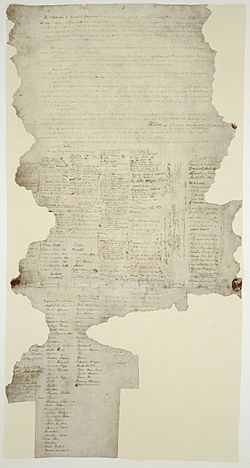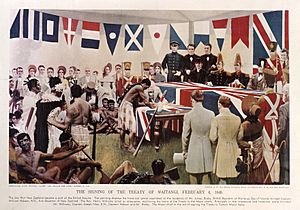Treaty of Waitangi facts for kids

The Waitangi Sheet of the Treaty of Waitangi
|
|
| Context | Treaty to establish a British Governor of New Zealand, consider Māori ownership of their lands and other properties, and give Māori the rights of British subjects. |
|---|---|
| Drafted | 4–5 February 1840 by William Hobson with the help of his secretary, James Freeman, and British Resident James Busby |
| Signed | 6 February 1840 |
| Location | Waitangi in the Bay of Islands, and various other locations in New Zealand. Currently held at National Library of New Zealand, Wellington. |
| Signatories | Representatives of the British Crown, various Māori chiefs from the northern North Island, and later a further 500 signatories |
| Languages | English, Māori |
The Treaty of Waitangi (Māori: Te Tiriti o Waitangi) is a very important treaty signed in New Zealand. It was first signed on 6 February 1840. The people who signed it were representatives of the British Crown (the British government) and Māori chiefs (called rangatira) from the North Island of New Zealand.
This treaty is a key document in New Zealand's history. It has shaped how the government and the Māori people interact, especially since the late 1900s.
Contents
Why Was the Treaty Created?
The treaty was written when the New Zealand Company was setting up a colony in New Zealand. Many British settlers wanted to move there. Some Māori leaders had also asked the British for help to protect them from French visitors.
The main goals of the treaty were:
- To set up a British Governor for New Zealand.
- To recognise that Māori owned their lands, forests, and other belongings.
- To give Māori people the same rights as British subjects.
The British Crown wanted to make sure Māori felt their rights were respected. This was important before Lieutenant Governor William Hobson officially declared British sovereignty (control) over New Zealand in May 1840.
Signing the Treaty
Once the treaty was written and translated, Northern Māori leaders signed it first. This happened at Waitangi. After that, copies were taken all around New Zealand. Many other chiefs signed the treaty over the next few months.
About 530 to 540 Māori people signed the Māori version of the Treaty of Waitangi. At least 13 of these signers were women. Some Māori leaders were careful and advised against signing it. One immediate result was that Queen Victoria's government gained the only right to buy land. There are nine signed copies of the Treaty of Waitangi in total. This includes the copy signed on 6 February 1840 at Waitangi.
What the Treaty Says
The treaty has an introduction and three main parts, called articles. It was written in both Māori and English. However, the Māori text was not perfectly translated from the English.
Article One: Governance and Sovereignty
- The Māori text of Article One gives "governance rights" to the Crown. This means the Crown could manage the country.
- The English text says Māori give up "all rights and powers of sovereignty" to the Crown. This means giving full control to the Crown.
Article Two: Land and Treasures
- The Māori text of Article Two says Māori will keep full "chieftainship" (control) over their lands, villages, and all their treasures (called taonga).
- The English text says Māori continue to own their lands. It also says only the Crown has the right to buy Māori land.
Article Three: Rights of British Subjects
- Article Three gives Māori people full rights and protections. These are the same rights that British subjects have.
Differences and Disagreements
The Māori and English versions of the treaty have very different meanings. This is especially true for the idea of having and giving up sovereignty (control). These differences caused many disagreements in the years after the treaty was signed. They even helped lead to the New Zealand Wars from 1845 to 1872.
During the second half of the 1800s, Māori lost control of much of their land. Sometimes this happened through fair sales. But often, it was due to unfair land deals. Settlers also took land that had not been sold. Some land was even taken by force after the New Zealand Wars.
The Treaty Today
After the New Zealand Wars, the New Zealand government mostly ignored the treaty. A court case in 1877 even said it was "a simple nullity" (meaning it had no legal power).
However, starting in the 1950s, Māori began to use the treaty more and more. They used it to ask for more rights and to get back lost land. In the 1960s and 1970s, governments started to listen. The treaty then became much more important in understanding land rights and the relationship between Māori people and the government.
In 1975, the New Zealand Parliament passed the Treaty of Waitangi Act. This law created the Waitangi Tribunal. The Tribunal is a group that:
- Interprets the treaty.
- Researches when the Crown (government) has broken the treaty.
- Suggests ways to fix these problems.
The Tribunal's suggestions are usually not legally binding on the Crown. However, Māori groups have received almost $1 billion in settlements. Many laws passed in the late 1900s mention the treaty. This means the treaty is now part of New Zealand law in many ways. It is now widely seen as the founding document of New Zealand.
Waitangi Day
The New Zealand government made Waitangi Day a national holiday in 1974. Every year, this holiday celebrates the date the treaty was signed.
Related pages
Images for kids
-
Captain William Hobson
-
Reverse of a 1990 one dollar coin commemorating the sesquicentenary of the Treaty of Waitangi. Using a different design a much rarer New Zealand crown commemorative coin was also minted in 1935.
See also
 In Spanish: Tratado de Waitangi para niños
In Spanish: Tratado de Waitangi para niños











